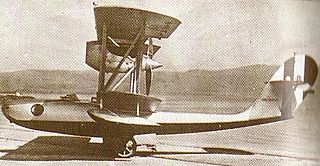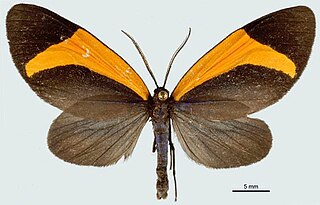The Royal Italian Air Force (RAI) was the name of the air force of the Kingdom of Italy. It was established as a service independent of the Royal Italian Army from 1923 until 1946. In 1946, the monarchy was abolished and the Kingdom of Italy became the Italian Republic, whereupon the name of the air force changed to Aeronautica Militare.

The Apostolic Palace is the official residence of the Pope, the head of the Catholic Church, located in Vatican City. It is also known as the Papal Palace, the Palace of the Vatican and the Vatican Palace. The Vatican itself refers to the building as the Palace of Sixtus V, in honor of Pope Sixtus V, who built most of the present form of the palace.

Crocomela is a genus of moths in the subfamily Arctiinae. The genus was described by William Forsell Kirby in 1892.

The CANT 25 was an Italian shipboard single-seat sesquiplane flying boat fighter that entered service with the Regia Aeronautica in 1931.

The Fiat B.R. 1/4 was a light bomber series, developed in Italy shortly after World War I.

Roystonea regia, commonly known as the Cuban royal palm or Florida royal palm, is a species of palm native to Mexico, the Caribbean, Florida, and parts of Central America. A large and attractive palm, it has been planted throughout the tropics and subtropics as an ornamental tree. Although it is sometimes called R. elata, the conserved name R. regia is now the correct name for the species. The royal palm reaches heights from 15–24 m (50–80 ft) tall. Populations in Cuba and Florida were long seen as separate species, but are now considered a single species.

Cyclophora is a genus of moths in the family Geometridae. Many species are referred to as mochas in reference to their colouration, primarily in Europe.

Scopula is a genus of moths in the family Geometridae described by Franz von Paula Schrank in 1802.

Crocomela flammifera is a moth of the subfamily Arctiinae first described by William Warren in 1904. It is found in Peru.

The Pericopina is a subtribe of tiger moths in the family Erebidae. The subtribe was described by Francis Walker in 1869.
Crocomela albolineata is a moth of the subfamily Arctiinae. It was described by Herbert Druce in 1911. It is found in Colombia and northern Ecuador.
Crocomela colorata is a moth of the subfamily Arctiinae. It was described by Francis Walker in 1865. It is found in Colombia and Peru.
Crocomela conscita is a moth of the subfamily Arctiinae. It was described by Herbert Druce in 1903. It is found in Peru.
Crocomela fusifera is a moth of the subfamily Arctiinae. It was described by Francis Walker in 1856. It is found in Colombia.
Crocomela imperialis is a moth of the subfamily Arctiinae. It was described by Herbert Druce in 1885. It is found in Ecuador.
Crocomela inca is a moth of the subfamily Arctiinae. It was described by Schaus in 1892. It is found in Peru and Bolivia.
Crocomela intensa is a moth of the subfamily Arctiinae. It was described by Francis Walker in 1854. It is found in Venezuela.
Crocomela rubriplaga is a moth of the subfamily Arctiinae. It was described by Warren in 1904. It is found in Ecuador.
Crocomela tripunctata is a moth of the subfamily Arctiinae. It was described by Herbert Druce in 1885. It is found in Ecuador.
Crocomela unifasciata is a moth of the subfamily Arctiinae. It was described by Herbert Druce in 1885. It is found in Ecuador.








